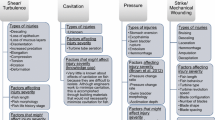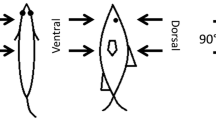Abstract
Because of growing interest in deploying newer very low head (VLH) turbine technology to generate electricity in rivers, there is a need to assess how fish fare in interactions with VLH turbines. We assessed injury and mortality rates from experimental VLH turbine entrainment of fish species local to the study site at Wasdell Falls on the Severn River, Ontario, which is one of the first such VLH installations in North America. Using balloon tags to recapture fish and before/after entrainment assessments, we found minimal injury and mortality differences between control (no entrainment) and treatment (entrainment) groups. One adult northern pike (Esox lucius Linnaeus, 1758; 1.16% of total entrained fish) was killed by turbine strike. Abrasion-related injuries (i.e., scale loss, torn fins) were the most common form of injury in both control and treatment fish, which was likely attributed to handling and not turbine passage per se. Telemetry monitoring of a subset of fish revealed that post-passage mortality was low. These results suggest that VLH turbine entrainment has negligible effects on the fish species studied here, and thus, VLH turbines may be suitable for increasing generating capacity at low head dam sites with minimal risk to fish.





Similar content being viewed by others
References
Algera, D. A., T. Rytwinski, J. J. Taylor, J. R. Bennett, K. E. Smokorowski, P. M. Harrison, K. D. Clarke, E. C. Enders, M. Power, M. S. Bevelhimer & S. J. Cooke, 2020. What are the relative risks of mortality and injury for fish during downstream passage at hydroelectric dams in temperate regions? A systematic review. Environmental Evidence 9: 3.
Boys, C., L. Baumgartner, B. Miller, Z. Deng, R. Brown & B. Pflugrath, 2013. Protecting downstream migrating fish at mini hydropower and other river infrastructure. Fisheries Final Report Series .
Čada, G. F., 2001. The development of advanced hydroelectric turbines to improve fish passage survival. Fisheries 26: 14–23.
Colotelo, A. H., S. J. Cooke, G. Blouin-Demers, K. J. Murchie, T. Haxton & K. E. Smokorowski, 2013a. Influence of water temperature and net tending frequency on the condition of fish bycatch in a small-scale inland commercial fyke net fishery. Journal for Nature Conservation 21: 217–224.
Colotelo, A. H., G. D. Raby, C. T. Hasler, T. J. Haxton, K. E. Smokorowski, G. Blouin-Demers & S. J. Cooke, 2013b. Northern pike bycatch in an inland commercial hoop net fishery: effects of water temperature and net tending frequency on injury, physiology, and survival. Fisheries Research 137: 41–49.
Colotelo, A. H., K. E. Smokorowski, T. Haxton & S. J. Cooke, 2014. Comparative evaluation of four presumptive tests for blood to detect epithelial injury on fish. Journal of Fish and Wildlife Management 5: 26–34.
Cooke, S. J., C. Hatry, C. T. Hasler & K. E. Smokorowski, 2011. Synthesis and proposed guidelines related to the biological evaluation of “fish friendly” very low head turbine technology in Canada. Canadian Technical Report of Fisheries and Aquatic Sciences 2931: 33.
Crans, K. D., N. A. Pranckevicius & G. R. Scott, 2015. Physiological tradeoffs may underlie the evolution of hypoxia tolerance and exercise performance in sunfish (Centrarchidae). Journal of Experimental Biology 218: 3264–3275.
Deng, Z., T. J. Carlson, J. P. Duncan & M. C. Richmond, 2007. Six-degree-of-freedom sensor fish design and instrumentation. Sensors 7: 3399–3415.
Elbatran, A. H., O. B. Yaakob, Y. M. Ahmed & H. M. Shabara, 2015. Operation, performance and economic analysis of low head micro-hydropower turbines for rural and remote areas: a review. Renewable and Sustainable Energy Reviews 43: 40–50.
Farlinger, S. & F. W. H. Beamish, 1977. Effects of time and velocity increments on the critical swimming speed of largemouth bass (Micropterus salmoides). Transactions of the American Fisheries Society 106: 436–439.
Fraser, R. & C. Deschênes, 2007. VLH: development of a new turbine for Very Low Head sites. Proceeding of the 15th Waterpower 10: 23–26.
Heisey, P. G., D. Mathur & L. D’Allesandro, 1993. A new technique for assessing fish passage survival at hydro power stations. St. John’s.
Hogan, T. W., G. F. Cada & S. V. Amaral, 2014. The status of environmentally enhanced hydropower turbines. Fisheries 39: 164–172.
Holbrook, C., T. Hayden, T. Binder, J. Pye & A. Nunes, 2019. glatos: a package for the Great Lakes Acoustic Telemetry Observation System. https://gitlab.oceantrack.org/GreatLakes/glatos.
Corp, I. B. M., 2019. IBM SPSS Statistics for Windows. IBM Corp, Armonk, NY.
Inoue, M. & E. Shiraishi, 2010. Hydropower as a renewable energy source in a new era. Science and Technology Trends – Quarterly Review 36: 79–100.
Jones, D. R., J. W. Kiceniuk & O. S. Bamford, 1974. Evaluation of the swimming performance of several fish species from the Mackenzie River. Journal of the Fisheries Board of Canada 31: 1641–1647.
Kemp, P., C. Williams, R. Sasseville & N. Anderson, 2014. Very low head turbine deployment in Canada. IOP Conference Series: Earth and Environmental Science 22.
Lagarrigue, T., 2013. Tests for evaluating damage to fish species migrating downstream during their transit through the VLH hydraulic turbine installed on the Tarn River in Millau. Prepared by Edtudes et Conseils en Gestion de L’Environment Aquatique (ECOGEA), Pins-Justaret, France.
Lagarrigue, T. & A. Frey, 2010. Test for evaluating the injuries suffered by downstream-migrating eels in their transiting through the new spherical discharge ring VLH turbogenerator unit installed on the Moselle river in Frouard. Report E. CO. GEA for MJ2 Technologies. .
Lagarrigue, T., B. Voegtle & J. Lascaux, 2008. Tests for evaluating the injuries suffered by downstream-migrating salmonid juveniles and silver eels in their transiting through the VLH turbogenerator unit installed on the Tarn River in Millau. Prepared by ECOGEA for Forces Motrices de Farebout Company, France.
Lautier, P., C. O’Neil, C. Deschenes, H. J. N. Ndjana, R. Fraser & M. Leclerc, 2007. Variable speed operation of a new very low head hydro turbine with low environmental impact. 2007 IEEE Canada Electrical Power Conference: 85–90.
Loots, I., M. van Dijkb, B. Bartac, S. J. van Vuurend & J. N. Bhagwane, 2015. A review of low head hydropower technologies and applications in a South African context. Renewable and Sustainable Energy Reviews 50: 1254–1268.
Mathur, D. & P. G. Heisey, 1992. Debunking the myths about fish mortality at hydro plants. Hydro Review 11: 54–60.
Mueller, M., J. Pander & J. Geist, 2017. Evaluation of external fish injury caused by hydropower plants based on a novel field-based protocol. Fisheries Management and Ecology 24: 240–255.
Oksanen, J., F. G. Blanchet, M. Friendly, R. Kindt, P. Legendre, D. McGlinn, P. R. Minchin, R. B. O’Hara, G. L. Simpson, P. Solymos, M. H. H. Stevens, E. Szoecs & H. Wagner, 2019. vegan: Community Ecology Package., https://cran.r-project.org/package=vegan.
Paish, O., 2002. Small hydro power: technology and current status. Renewable and Sustainable Energy Reviews 6(6): 537–556.
Peake, S., 2004a. Effect of approach velocity on impingement of juvenile northern pike at water intake screens. North American Journal of Fisheries Management Taylor & Francis 24: 390–396.
Peake, S., 2004b. An evaluation of the use of critical swimming speed for determination of culvert water velocity criteria for smallmouth bass. Transactions of the American Fisheries Society Wiley Online Library 133: 1472–1479.
Peake, S., R. S. McKinley & D. A. Scruton, 2000. Swimming performance of walleye (Stizostedion vitreum). Canadian Journal of Zoology NRC Research Press 78: 1686–1690.
R Core Team, 2019. R: A Language and Environment for Statistical Computing. Vienna, Austria, Austria, http://www.r-project.org/.
Reid, C. H., C. S. Vandergoot, J. D. Midwood, E. D. Stevens, J. Bowker & S. J. Cooke, 2019. On the electroimmobilization of fishes for research and practice: opportunities, challenges, and research needs. Fisheries 44: 576–585.
Sahin, O., R. A. Stewart, D. Giurco & M. G. Porter, 2017. Renewable hydropower generation as a co-benefit of balanced urban water portfolio management and flood risk mitigation. Renewable and Sustainable Energy Reviews 68: 1076–1087.
Skalski, J. R., D. Mathur & P. G. Heisey, 2002. Effects of turbine operating efficiency on smolt passage survival. North American Journal of Fisheries Management 22: 1193–1200.
Stokesbury, K. D. E. & M. J. Dadswell, 1991. Mortality of Juvenile Clupeids during Passage through a Tidal, Low-Head Hydroelectric Turbine at Annapolis Royal, Nova Scotia. North American Journal of Fisheries Management 11: 149–154.
Veilleux, M. A. N., J. D. Midwood, N. W. R. Lapointe, R. Portiss, M. Wells, S. E. Doka & S. J. Cooke, 2018. Assessing occupancy of freshwater fishes in urban boat slips of Toronto Harbour. Aquatic Ecosystem Health and Management 21: 331–341.
Acknowledgements
All research was conducted in accordance with the guidelines of the Canadian Council for Animal Care. Funding was provided by Fisheries and Oceans Canada (Strategic Program for Ecosystem-Based Research and Advice and the Fish and Fish Habitat Protection branch) and Carleton University. We thank Enbridge Power Operations for site access, turbine operation adjustment as required, and provision of assistance from their site operator Glenn Hepinstall, who was extremely helpful throughout this project. We also thank Fisheries and Oceans Canada assistance from Stephanie Best, Anne-Sophie Fabris, Marla Thibodeau, and Jenna Webb, as well as assistance from Carleton University by Dirk Algera, Jacqueline Chapman, Benjamin Hlina, Elodie Lédée, Amanda Jeanson, Sarah Walton, and Graham Raby.
Author information
Authors and Affiliations
Corresponding author
Additional information
Publisher's Note
Springer Nature remains neutral with regard to jurisdictional claims in published maps and institutional affiliations.
Guest editors: Ingeborg P. Helland, Michael Power, Eduardo G. Martins & Knut Alfredsen / Perspectives on the environmental implications of sustainable hydro-power
Rights and permissions
About this article
Cite this article
Tuononen, E.I., Cooke, S.J., Timusk, E.R. et al. Extent of injury and mortality arising from entrainment of fish through a Very Low Head hydropower turbine in central Ontario, Canada. Hydrobiologia 849, 407–420 (2022). https://doi.org/10.1007/s10750-020-04376-x
Received:
Revised:
Accepted:
Published:
Issue Date:
DOI: https://doi.org/10.1007/s10750-020-04376-x




